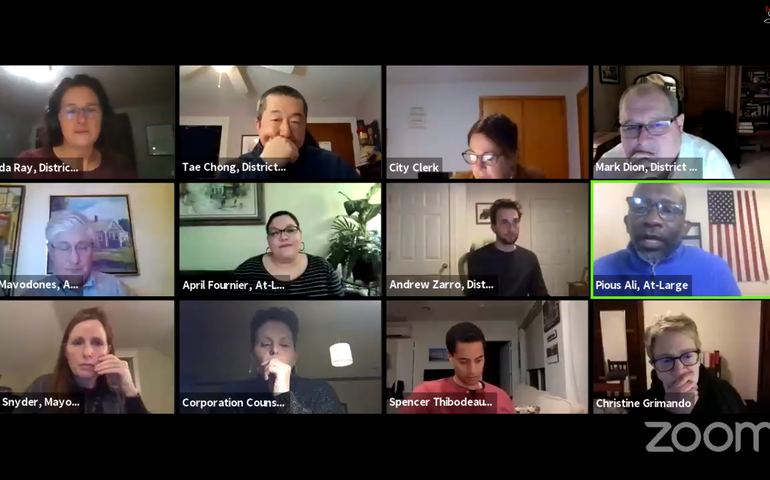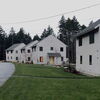Processing Your Payment
Please do not leave this page until complete. This can take a few moments.
- News
-
Editions
View Digital Editions
Biweekly Issues
- December 1, 2025
- Nov. 17, 2025
- November 03, 2025
- October 20, 2025
- October 6, 2025
- September 22, 2025
- + More
Special Editions
- Lists
- Viewpoints
-
Our Events
Event Info
Award Honorees
- Calendar
- Biz Marketplace
Portland City Council votes down Munjoy Hill historic district proposal
 Image / Zoom screen capture
Portland City Councilor Pious Ali, right center, speaks about the Munjoy Hill Historic District proposal Monday night at the city council meeting. He and four other councils voted against it.
Image / Zoom screen capture
Portland City Councilor Pious Ali, right center, speaks about the Munjoy Hill Historic District proposal Monday night at the city council meeting. He and four other councils voted against it.
A proposal for a historic district that would have included hundreds of properties on Munjoy Hill was rejected by the Portland City Council Monday night, with councilors on both sides of the vote saying they are concerned about maintaining affordable housing and diversity in the neighborhood.
The council rejected the plan, 5-4, after more than two hours of public comment and discussion. Affordability and lack of access to housing for the city's working class, many of whom are Black and Brown immigrants, were at the heart of arguments on both sides of Monday's discussion.
Councilors opposed to the district said they didn't have enough information on the economic impact to vulnerable communities and on affordable housing to approve the proposal.
Some said they'd like to see an economic impact analysis of how historic districts affect a neighborhood, an idea the board may still pursue, but wasn't part of Monday's vote.
The Munjoy Hill Historic District would have been the city's 12th historic district, and would have included 376 conforming properties over 64 acres in the 162-acre area.
The one-time working class neighborhood and immigrant enclave is now the city's most expensive place to live, with average rents at $1,482, city staff said.
Some 41 members of the public spoke before the council took its vote, the majority in favor, but those on both sides citing lack of affordable housing in the city, as well as policies and development trends that stymie diversity as issues. Many of those opposed also said they didn't want more rules about how they could renovate their property.
Focus on working class, immigrants
Mark Dion, District 5 councilor, said that he'd done a lot of reading on the economic effects, and it was hard to discern which decision is best for supporting affordable housing and diversity.
"However we decide tonight , there are some questions about racial disparity, and we don't have all the answers and maybe we will never get all the answers," he said. "But we can’t dismiss the critiques as minor."
Dion was one of four councilors to vote in favor of the district. He was joined by Snyder; Belinda Ray, District 1, which includes Munjoy Hill; and Spencer Thibodeau, District 2. Opposed were Pious Ali, at-large; April Fournier, at-large; Nicholas Mavodones, District 2; Tae Chong, District 3; and Andrew Zarro, District 4.
Chong said if the city wants to maintain affordability, it should focus more closely on neighborhoods where working-class immigrants live, particularly those at the base of the Hill.
The area "is already exclusive, already desirable," he said. The district, he said, will just make that worse. "Whenever you create any type of scarcity, it automatically increases the overall value."
Fournier said she had "a hard time with neighbors making decisions for others," about what constitutes their home. She also said she didn't see many Black and brown residents of the community included in the conversation.
Ali, who said he was torn about the vote, added, "Most of people who reach out to me are not so much concerned about the look of the buildings, they’re concerned about tear downs."
Supporters on the council were also focused on diversity, tear-downs and affordable housing.
"We're losing housing, we're losing affordable rents," Ray said. She said that before a 2018 overlay and moratorium that preventing buildings from being torn down "they were being replaced by buildings that were much larger, but not increasing density, not being built with the working class in mind."
She and others in favor said that the historic district will preserve the older housing stock designed for apartments and density, while still allowing development. "We’re talking about sustainability, we're talking about affordability, we're talking about economic development," she said.
Five landmarks approved
The council did approve five landmark designations recommended by the Historic Preservation Board, 101-107 Congress St., 7 Lafayette St., 8-12 Montreal St., 51 Monument St. and 28 Waterville St. The house at 21 Sheridan St., the childhood home of film director John Ford, wasn't included because of a technical issue.
Landmark designation means any exterior alteration or addition requires review and approval, whether or not the change is visible from a public way.
The historic district was approved by the Historic Preservation Commission in November 2019 and by the Planning Board in August, in a 4-3 vote where members had many of the came concerns the council had Monday. The board's vote came after several years of debate, zoning changes and the overlay district in 2018 that slowed construction because of concerns about buildings being torn down and larger condominium buildings going up in their place.
The proposed district included 427 parcels, of which 376, or 88% are classified as contributing, which means that they meet the criteria for age and retained historic features. Overall, the district would have represented 49% of Munjoy Hill’s building stock. Most of the proposed historic district property is in an R-6 residential zone, but it also includes 10 buildings in the neighborhood’s B-1 or B-1b business zones. Two of those buildings are previously designated landmarks.
Mainebiz web partners

The Giving Guide
The Giving Guide helps nonprofits have the opportunity to showcase and differentiate their organizations so that businesses better understand how they can contribute to a nonprofit’s mission and work.
Learn More
Work for ME
Work for ME is a workforce development tool to help Maine’s employers target Maine’s emerging workforce. Work for ME highlights each industry, its impact on Maine’s economy, the jobs available to entry-level workers, the training and education needed to get a career started.
Learn More
Groundbreaking Maine
Whether you’re a developer, financer, architect, or industry enthusiast, Groundbreaking Maine is crafted to be your go-to source for valuable insights in Maine’s real estate and construction community.
Learn more-
The Giving Guide
The Giving Guide helps nonprofits have the opportunity to showcase and differentiate their organizations so that businesses better understand how they can contribute to a nonprofit’s mission and work.
-
Work for ME
Work for ME is a workforce development tool to help Maine’s employers target Maine’s emerging workforce. Work for ME highlights each industry, its impact on Maine’s economy, the jobs available to entry-level workers, the training and education needed to get a career started.
-
Groundbreaking Maine
Whether you’re a developer, financer, architect, or industry enthusiast, Groundbreaking Maine is crafted to be your go-to source for valuable insights in Maine’s real estate and construction community.
ABOUT
NEW ENGLAND BUSINESS MEDIA SITES
No articles left
Get access now
In order to use this feature, we need some information from you. You can also login or register for a free account.
By clicking submit you are agreeing to our cookie usage and Privacy Policy
Already have an account? Login
Already have an account? Login
Want to create an account? Register
Get access now
In order to use this feature, we need some information from you. You can also login or register for a free account.
By clicking submit you are agreeing to our cookie usage and Privacy Policy
Already have an account? Login
Already have an account? Login
Want to create an account? Register







0 Comments